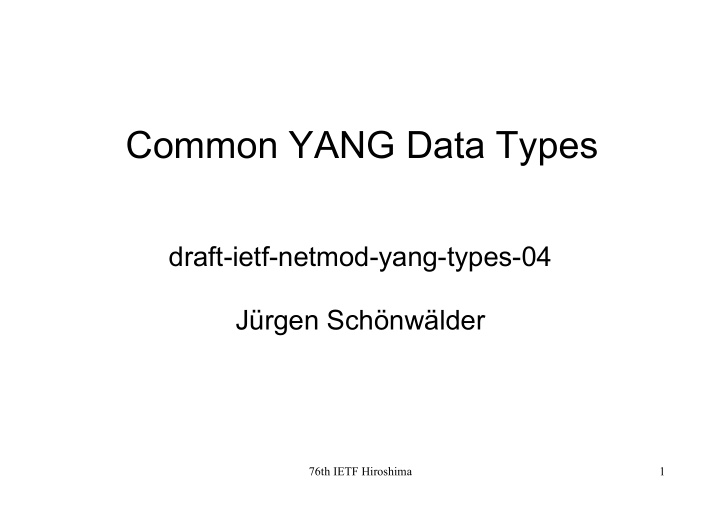



Common YANG Data Types draft-ietf-netmod-yang-types-04 Jürgen Schönwälder 76th IETF Hiroshima 1
changes since -03 The date-and-time canonicalization text has been updated based on mailing list discussions - please review Several editorial changes including boilerplate updates and the removal of the generated XSD and RNC appendixes 76th IETF Hiroshima 2
mac-address canonicalization The description should specify that lower-case characters are used in the canonical representation description "The mac-address type represents an IEEE 802 MAC address. The canonical representation uses lower-case characters. This type is in the value set and its semantics equivalent to the MacAddress textual convention of the SMIv2."; 76th IETF Hiroshima 3
mac-address canonicalization description "The mac-address type represents an IEEE 802 MAC address. The canonical representation uses lower-case characters. This type is in the value set and its semantics equivalent to the MacAddress textual convention of the SMIv2."; 76th IETF HIroshima 4
‘real’ typedef Early versions of YANG included real types After WG discussions, YANG’s real type was replaced in favour of a decimal64 type YANG’s decimal64 type requires the fraction-digits statement, which defines and fixes the location of the decimal point (and thus the range of numbers that can be represented) David Spakes proposed to a typedef ‘real’, which is essentially a union of all possible decimal64 / fraction- digits combinations plus some exceptional enums 76th IETF Hiroshima 5
‘real’ typedef Options to choose from: a) Add the proposed ‘real’ typedef b) Make the usage of fraction-digits optional in YANG c) Do nothing (no change to YANG, no ‘real’ typedef) d) Restart the discussion of builtin types versus derived types Note - XSD has an xsd:decimal type where the fractionDigits facet is optional 76th IETF Hiroshima 6
Recommend
More recommend